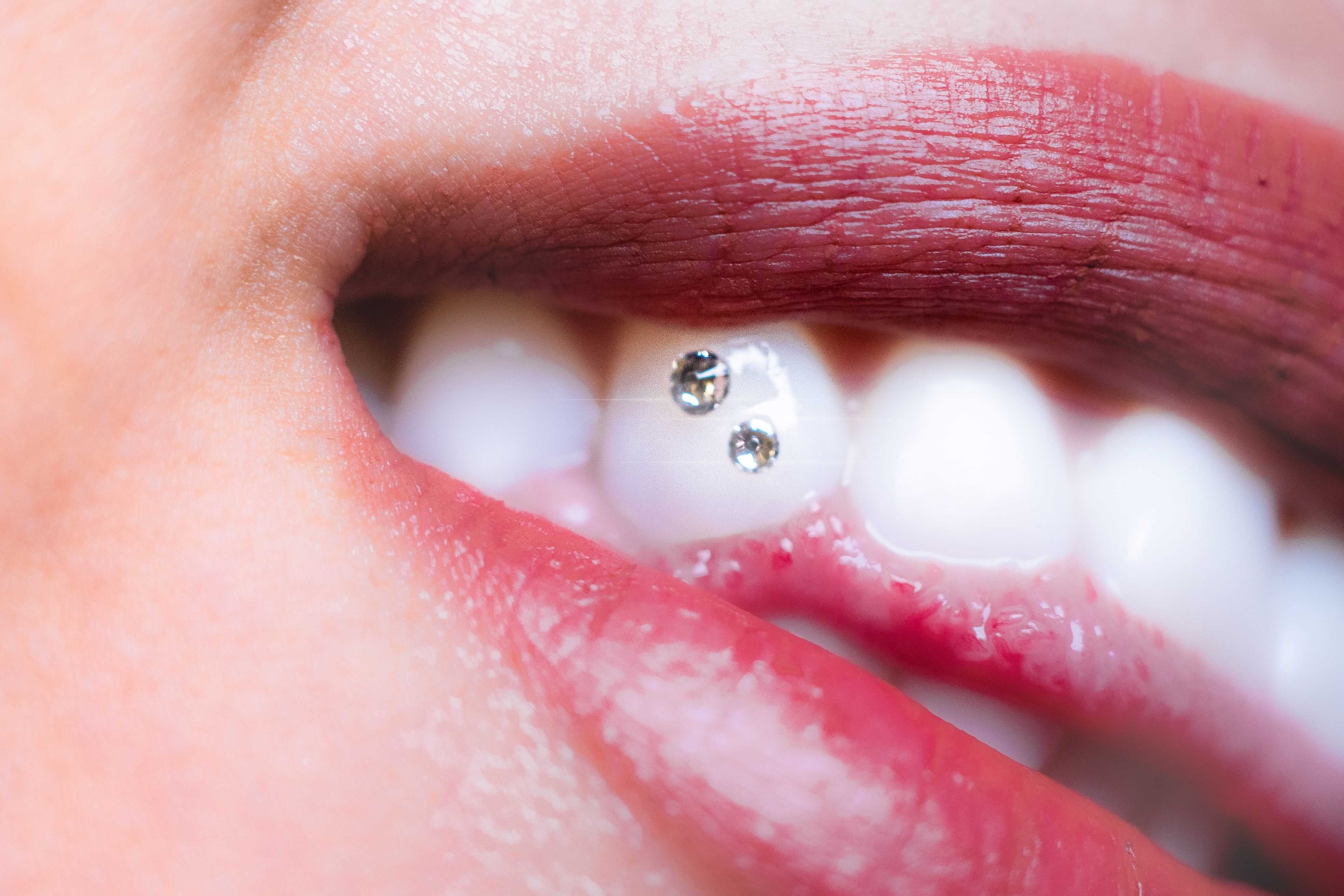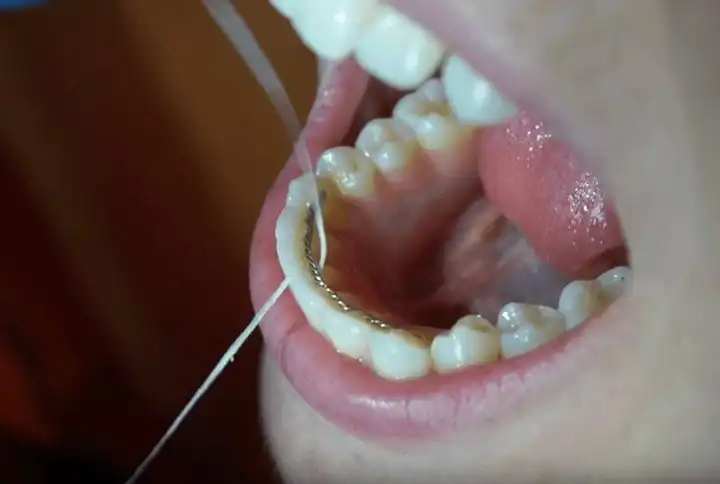Tooth Gems: Are They Safe? Dental Expert Reacts


Tooth gems were a popular trend in the 90s and early 2000s and just like stovepipe pants and low-rise jeans, they're starting to make a comeback. Teeth jewelry isn't anything new; in fact, it goes back thousands of years in cultures like the ancient Mayans. But are tooth gem trends safe and do they pose an oral health risk like cavities?
If you’re thinking about putting a gem on your teeth or have a teen who wants them, there are some things to consider before investing in tooth jewelry. Here's everything you need to know before trying DIY tooth gems at home or asking your dentist to bond them to your teeth.
What Are Tooth Gems?
Simply put, tooth gems are a type of dental jewelry and a form of self-expression that you install on the front teeth that are visible when you smile. There might only be one or you could get several. Tooth gems can be small and colorful, pricey or inexpensive, and placed on any tooth for added "bling".
Like a tiny nose piercing, tooth gems look like small crystals that sparkle when the light hits them just right.
There are two types of tooth gems: temporary and permanent. Temporary gems are removable and similar to orthodontic brackets. They're held there with a special bonding agent over the surface of your tooth. On the flip side, permanent teeth jewelry is fitted inside of a hole created in your tooth structure.
Older variations of tooth gems in the days of the ancient Mayans were often large, permanent gems or metals. Some people even think they served an antimicrobial purpose, given the materials that were used and the type of people who had teeth jewelry. For example, they may have thought that where the jewels were placed helped protect teeth against damage, wear, or decay. Precious materials like jade or hematite were often used.
Today, tooth gems can be a basic rhinestone or inexpensive crystal, or as fancy as solid diamonds and sapphires. There are even Swarovski crystals specifically branded for use on teeth!
How Do Tooth Gems Adhere To Your Teeth?
If for some reason you were getting permanent teeth jewelry, your dentist would need to complete a process similar to a dental filling. First, they would numb the tooth and then reshape the enamel to create a concavity in the surface, at which point they would cement the gem to your tooth.
You should not ever, ever try to bond gemstones on teeth by yourself. Not only could you trap bacteria under the tooth jewelry and give yourself a cavity, but most adhesives are not safe to swallow. Even superglue is toxic and dangerous to use in your mouth!
Can Tooth Gems Give You Cavities?
Like orthodontic appliances, tooth gems can get plaque or food buildup around them, so oral hygiene routines need to be thorough. It’s best to use a soft toothbrush around each side of your tooth jewelry to clean around all of the edges. That way you can make sure there’s no plaque creating a ring around the crystals like you would see with an orthodontic bracket.
Some dental professionals even recommend that you don’t use an electric toothbrush to clean teeth with dental jewelry, because it can shake the tooth gem off your teeth.
If you don’t have a good enough oral hygiene routine and skip over a little plaque every day, gemstones on teeth can easily trap bacteria. It would only be a matter of time before that part of your tooth got a cavity and you need a filling.
Fortunately, most tooth gems are bonded to front, prominent teeth. That makes them easier to clean because you can look at them straight in the mirror!
Are Tooth Gems Safe For Your Teeth: Pros and Cons
Knowing that most tooth gems are temporary means you won’t have to worry about any major oral health issues or long-term maintenance.
The downside of putting gems on teeth is that:
- You have to be careful about plaque getting caught around them
- You don’t want permanent tooth jewelry that’s going to reshape your tooth. Any time we adjust the shape of your tooth enamel, like when you get a filling, it’s only a matter of time before those areas have to be re-treated after the margins around them start to leak. And if your tooth gems are placed too close to your gums, it can trigger swelling and bleeding in those areas because of the constant irritation and food debris getting caught.
There’s also the cost to consider. Do you want to pay for tooth jewelry that’s only going to last 6-12 months? Maybe it’s affordable enough to be worth it, but maybe it isn’t. That’s a decision that only you can make.
How Long Can I Keep My Tooth Gems?
A typical temporary or semi-permanent tooth gems usually lasts about 6-12 months. Remember, the dental materials used like bonding agents work similarly to what an orthodontist uses to attach braces to your teeth. There are some factors that could cause your tooth jewelry to fall off before that, such as:
- Brushing too hard or using an electric toothbrush
- Biting down on something hard or crunchy, like a carrot or nuts
- Acidic diets that cause the bonding agents to fail
- Not having your gemstones attached by a dental professional with the right type of bonding agent
Are Tooth Gems Permanent?
Most of the time when we’re talking about gemstones on teeth, it’s the temporary or semi-permanent ones that your dentist bonds to the outside of your tooth. It isn’t permanent and even if the gemstone falls off and there’s some glue left behind, your dentist can buff it off. But let’s say you want to have your tooth gems removed for whatever reason—maybe some unexpected job interview or portrait session—your dentist will simply “pop” them off sort of the same way they do a bracket if you had braces.
If your tooth jewelry is permanent, it means your dentist drilled inside of your tooth and attached the gem with special cement, like getting a filling or crown. Those tooth gems can last 7-10 years or longer.
To enhance the durability of your tooth gems, it is essential to provide proper maintenance. For the initial 24-hour period following application, steer clear of tough or acidic foods that could impede the bonding of the tooth gems. Additionally, ensure that you brush and floss the surrounding areas to prevent plaque buildup, cavities, and tooth decay.
How Much Do Tooth Gems Cost?
The price tag for putting a tooth gem on your teeth will depend on two things: the fee charged by your dentist and the type of crystal you’re getting. Real diamond or sapphire? Well, then you’re going to pay more than you would an inexpensive little rhinestone. You could be paying as little as $50 to get a dentist to install teeth jewelry for you. Think of the tooth gems cost like an expensive earring! Only there’s a risk you might swallow it at some point.
The whole process only takes about 15 to 20 minutes depending on the style of tooth gem and how many you get. To attach the dental gems securely, the enamel is first treated with an etching gel to create microscopic roughness that enhances the tooth gem adhesion. After the microscopically roughening, the dental-grade adhesive and a curing lamp are used to bond the dental jewelry firmly in place. After the tooth gems applied, you might feel tooth sensitivity from the etching gel if you have worn tooth enamel.
DIY Tooth Gems: Should You Try It?
Absolutely do not, whatsoever, apply a DIY tooth gem to your teeth. First of all, you run the risk of trapping bacteria between the tooth jewelry and your enamel. Second, the glue that’s used could either be toxic (think superglue) or not as strong as what your dentist uses. Plus, you need to be sure of the positioning of the tooth gem in relation to your gumlines, other soft tissues like your lips and cheeks, and how your teeth bite together.
Related: TikTok Dental Trends Are Ruining People’s Teeth
Talk With Your Dentist
If you want to get tooth gems, find out if your dentist is comfortable installing one for you. They might even have you buy the tooth jewelry and then bring it to the office where they’ll apply it. But first, make sure your teeth and gums are totally healthy. You don’t want to accidentally have too many “bad” bacteria floating around inside your mouth because of cavities and gum disease, then add something else for them to attach themselves to.
You’d be surprised to hear the types of things people want to be put on their teeth (including sports team logos on their dental crowns.) If you’re embarrassed about asking your dentist to install a tooth gem, it’s not a big deal whatsoever.
Is Dental Jewelry For You?
Teeth jewelry is safe to wear as long as you clean around it well and have your tooth gems applied by a licensed dental professional. Personally, I think temporary gemstones on teeth are better than permanent ones because there’s no physical alteration to your natural tooth structure. For pricing on tooth jewelry, ask your dentist.

Make your inbox smile!







